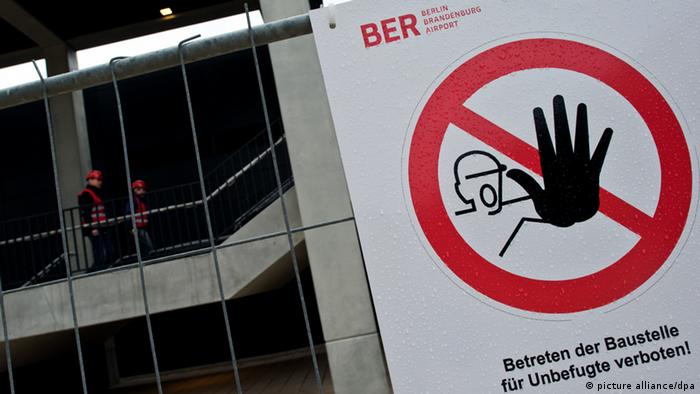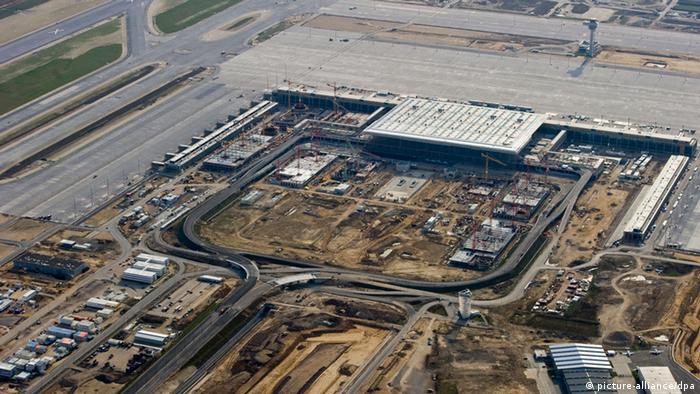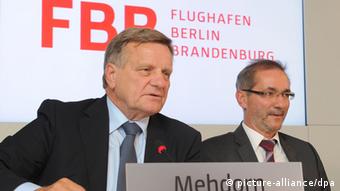柏林新機場“豆腐渣工程”讓人無語的細節
柏林-勃蘭登堡國際機場原本是柏林的面子工程,卻因施工質量不過關,耗資不斷增多,交工多次推延等成了“丟面子”工程。

(德國之聲中文網)柏林-勃蘭登堡國際機場(BER Airport)2006年破土動工以來,施工過程就沒順利過。這一工程讓德國也在國際上成了笑料,認為德國人連個機場都蓋不好。
一系列的錯誤人選
先說說新機場防火系統的主策劃師迪毛羅(Alfredo di Mauro),他並不是工程師,而只是工程圖紙繪製師。這一點他自己也承認了。他向德新社證實,自己多年來是負責新機場工程承建的策劃公司的員工,但並非固定員工:"公司把我當工程師看待,我也沒反駁。"今年5月,柏林新機場總裁梅多恩(Hartmut Mehdorn)炒了迪毛羅的魷魚。
2012年8月應聘擔任新機場技術總監的阿曼(Horst Amann)曾被認作是能解決機場所面臨困境的救星。事實證明,他也不是正確的人選。他手下的員工說,這位技術總監完全應對不了局面。阿曼之後也被辭退。他的繼任,總策劃師特普費爾(Regina Toepfer)也在今年2月被下崗。
柏林新機場項目的批評者認為,這一項目失敗的原因組要在於項目負責人和監官方的失職。工程監事會的兩位總負責人曾是柏林市長和勃蘭登堡州長,而並非懂工程項目的專業人員。

導致機場遲遲不能交工的主要癥結在防火系統上。早在2012年5月,這方面的嚴重工程質量問題就已經得到曝光。而直到今天,新機場的通風系統仍然不過關。而原因很簡單:設計師最初設計的通風口不是向上、或向四周將煙霧排除機場建築,而是從地下的管道排出。這是設計此類大型建築工程的大忌。現在所有設計要推翻重來。西門子和博世兩家公司現在負責設計建造新的防火通風系統。
機場前一任技術總監格羅斯曼(Jochen Grossmann)還涉嫌受賄50萬歐元。機場項目圈內還傳出消息,說此人涉嫌採取有違市場公平競爭原則,參與幕後操作建造價格。
各種設計錯誤
除了防火通風系統工程質量嚴重不過關,機場其他硬件設施也存在大量問題,比如線路管道鋪設不符合安全標準,登機辦理台數量過少,行李傳送帶數量也不夠,製冷設備功率太低等等,製冷方面出了差錯,會導致各種電子產品過熱停機。
機坪跑道的設計也有欠缺。比如如果兩架飛機並排起飛,飛行員必須升空後迅速改變方向,遠離對方,否則有可能出現空中衝撞等危險事故。起飛跑道的設計也沒有充分考慮噪音污染,因此也要重新設計。

柏林新機場項目總負責人梅多恩
柏林-勃蘭登堡國際機場是為了能滿足2700萬客流量建造的機場。不過已有專家表示,機場目前的規模難以承受這麼大的客流量,恐怕不久後就要擴建。
"瘋狂教訓"
2006年機場開始建造時,資金預算為25億歐元。現在,這一數字幾乎翻番,增加到47億歐元,而且隨著交工延誤的每一天,都又有更多經濟損失要承擔。已經有預計說,最終機場耗資可達80億歐元。如果最初的投資方案失效,最終有可能要由納稅人來買單。
媒體同時報導,曾經給該項目撥款3000萬歐元贊助的歐盟委員會現在考慮,這筆錢是否要如數償還?例如柏林航空公司等由於機場交工日期延誤無法正常營業的公司也已經要求獲得賠償,金額高達4800萬歐元。
更加尷尬的是,目前還沒有項目負責人敢宣布機場交工究竟何時?此前提上日程的幾個時間都被一推再推。德國聯邦議院交通事務委員會負責人馬丁·布爾科特(Martin Burket)今年5月曾表示,柏林新機場恐怕要在2017年完工。
德國新聞雜誌《明鏡周刊》甚至不無諷刺地建議,在一個全新的地方選址建造新機場,一切徹底重來。而柏林這個未完工的機場,就當作紀念館,讓人們記住這一"自不量力導致的瘋狂教訓"。
作者:Iveta Ondruskova 編譯:謝菲
責編:萬方
How Berlin’s Futuristic Airport Became a $6 Billion Embarrassment
Inside Germany’s profligate (Greek-like!) fiasco called Berlin Brandenburg
July 23, 2015
by Joshua Hammer
Share on FacebookShare on Twitter

Photographer: Eriver Hijano for Bloomberg Businessweek
The inspectors could hardly believe what they were seeing. Summoned from their headquarters near Munich, the team of logistics, safety, and aviation experts had arrived at newly constructed Berlin Brandenburg International Willy Brandt Airport in the fall of 2011 to begin a lengthy series of checks and approvals for the €600 million ($656 million) terminal on the outskirts of the German capital. Expected to open the following June, the airport, billed as Europe’s “most modern,” was intended to handle 27 million passengers a year and crown Berlin as the continent’s 21st century crossroads.
The team of inspectors, known as ORAT, for Operations Readiness and Airport Transfer, brought in a dummy plane and volunteers as test passengers. They examined everything from baggage carousels and security gates to the fire protection system. The last was an especially high priority: None could forget the 1996 fire that roared through Düsseldorf Airport’s passenger terminal, killing 17.
When they simulated a fire, though, the system went haywire. Some alarms failed to activate. Others indicated a fire, but in the wrong part of the terminal. The explanation was buried in the 55-mile tangle of wiring that had been laid, hastily, beneath the floors of the building where ORAT technicians soon discovered high-voltage power lines alongside data and heating cables—a fire hazard in its own right. That wasn’t all. Smoke evacuation canals designed to suck out smoke and replace it with fresh air failed to do either. In an actual fire, the inspectors determined, the main smoke vent might well implode.

Photographer: Eriver Hijano for Bloomberg Businessweek
Confronted with the fire system fiasco, Rainer Schwarz, chief executive officer of Flughafen Berlin Brandenburg (FBB), the airport company owned by the city of Berlin, the state of Brandenburg, and the federal government, downplayed it. Schwarz and his staff told the airport’s board of oversight, as well as Stephan Loge, the commissioner of Dahme-Spreewald County, who had the final authority to issue the airport an operating license, that they were working through some issues, but that the situation was under control. Schwarz also appointed an emergency task force to propose solutions that would allow the airport to open on time. In March 2012 the group submitted its stopgap: Eight hundred low-paid workers armed with cell phones would take up positions throughout the terminal. If anyone smelled smoke or saw a fire, he would alert the airport fire station and direct passengers toward the exits. Never mind that the region’s cell phone networks were notoriously unreliable, or that some students would be stationed near the smoke evacuation channels, where in a fire temperatures could reach 1,000F.
It was, says Martin Delius, “an idiotic plan.” Delius is a physicist and member of Berlin’s parliament who has conducted an extensive investigation of the airport’s troubled infrastructure. “They thought that this would at least eliminate the need for wiring,” he says, “because [the spotters] could see with their own eyes if there is a mass of smoke lower than 6 feet above the ground.”

Photographer: Michael Sohn/AP Photo
Schwarz continued to prepare for the opening, and the German public remained oblivious. By April 2012, airport fever was consuming Berlin. Mayor Klaus Wowereit sent out 3,000 invitations for the Hoffest, the annual mayoral ball at the 19th century City Hall, printing the entry tickets on mock boarding cards. Billboards went up, showing a photomontage of the airport’s namesake and famous Cold War leader embracing passengers, with the legend, “Willy Brandt greets the world!” Preparations continued for an extravagant inaugural. Angela Merkel, the chancellor, was to disembark from a government jet and stroll down a red carpet to the glass-walled terminal, which would have been filled with expensive food and drink. On the night of June 2, in a stunt-like mobilization, thousands of workers would shuttle 600 truckloads of equipment and a fleet of 60-ton aircraft tugs 19 miles down a sealed-off expressway from Berlin-Tegel, Berlin’s main airport, in the northwest corner of the city, and Tegel would shut down forever the same day the new airport came online.
But in the town of Lübben, in what used to be East Germany, Commissioner Loge had his doubts. He and his own staff of building inspectors had spent many hours examining the fire protection system at the Tropical Islands Resort, an indoor paradise set in a former airship hangar in Brandenburg. One of the world’s largest freestanding structures, it draws up to 6,000 warmth-and-beach-deprived Germans a day. “It was far more complicated than the one at Berlin Brandenburg airport, and it worked,” Loge says.
On May 7, less than four weeks before the scheduled opening, Loge met with Schwarz for the first time. The airport, Schwarz conceded, would have to open using the army of human fire detectors.
“Professor, let me understand this,” Loge said. “You are talking about having 800 people wearing orange vests, sitting on camping stools, holding thermoses filled with coffee, and shouting into their cell phones, ‘Open the fire door’?” Loge refused the airport an operating license. Schwarz stood up and walked out without another word.
The next day, in a hall packed with government officials and journalists, Schwarz sat grimly behind a table with four other officials, including Mayor Wowereit, and announced the unthinkable: The airport wouldn’t open as scheduled. The inaugural bash and overnight move from Tegel were scuttled.
It was merely a prelude to a debacle that is still unfolding. Three years later, Berlin Brandenburg has wrecked careers and joined two other bloated projects—Stuttgart 21, a years-late railway station €2 billion over budget, and an €865 million concert hall in Hamburg—in tarnishing Germany’s reputation for order, efficiency, and engineering mastery.
At the very moment Merkel and her allies are hectoring the Greeks about their profligacy, the airport’s cost, borne by taxpayers, has tripled to €5.4 billion. Two airport company directors (including Schwarz), three technical chiefs, the architects, and dozens if not hundreds of others have been fired or forced to quit, or have left in disgust. The government spends €16 million per month just to prevent the huge facility from falling into disrepair. According to the most optimistic scenarios, it won’t check in its first passengers until 2017, and sunny pronouncements have long since given way to “catastrophe,” “farce,” and “the building site of horror.” There is a noted German word for the delight some took in the mess, too.

Breaking ground in September 2006.
Photographer: Gunter Wicker/Berlin Brandenburg Airport
In the beginning, Berlin Brandenburg airport was at best an economically unnecessary symbol of unity and growth. In October 1990, when politicians and planners began a search for ways of bridging the city’s long East-West divide, Berlin had three modest-size airports: Tempelhof, famed as the site of the 1948 Berlin Airlift; Schönefeld, opened in 1946, which later became the main airport serving Communist East Germany; and Tegel, a gem of efficiency that opened in 1948. By 1995 about 12 million people flew in and out of the city each year. After years of languishing as a Cold War backwater, Berlin was on the rise. By 2020, passenger totals were projected to reach 22 million.
In 2001, Wowereit sensed an opportunity. A gray-haired extrovert who bears a certain resemblance to the actor Alec Baldwin, “Wowi,” as he’s known, had earned a reputation as both a party animal and a rainmaker. He attracted free-spirited events to the city, such as an international S&M fetish street party, and proudly proclaimed, “I’m gay, and that’s a good thing.” “Is Germany Ready for a Gay Chancellor?” Der Spiegel asked after the Social Democrat’s landslide reelection in 2006. The Berlin Brandenburg Willy Brandt Airport was to be his legacy in the city, while possibly paving the way for national office. (Wowereit declined to be interviewed for this article.)
To design the airport, FBB landed Meinhard von Gerkan, Germany’s most famous architect, a septuagenarian with a mane of white hair who’d made his name at age 30 with the Tegel Airport. The founding partner of Hamburg-based firm von Gerkan, Marg, & Partners, he’s known to squabble publicly with project managers when he feels that his artistic vision has been compromised.
The third key player was Schwarz, who was appointed CEO of the airport management company in 2006. A U.S.-trained economist who’d run Düsseldorf Airport, Schwarz had a reputation as a cost-cutting technocrat—just the man for the job. After considering a half-dozen sites, including a former Russian army base, the airport management team from FBB broke ground in 2006 on a vast plot just a couple of miles from the existing runways at Schönefeld.
The project’s first complications stemmed from Schwarz and Wowereit’s ever-changing ambitions. With construction under way, Schwarz, seizing on increasing forecasts for air traffic (up to 27 million passengers at that point), had von Gerkan add north and south “piers” to the main terminal, turning it from a rectangle into a “U” and dramatically enlarging the floor space. Schwarz also dreamed of making the airport a Dubai-like luxury mall. Airports earn significant money from nonaviation businesses, the FBB boss noted, so why not insert a second level, jammed with shops, boutiques, and food courts? Von Gerkan derided what he called the Vermallung of the airport—its “mallification”—but he capitulated to Schwarz’s demands.
According to Boris Hermel, a TV and radio correspondent who has covered the airport saga from the beginning, and other sources, Wowereit and Schwarz fell hard for an airplane: the Airbus A380, the double-decker, widebody, four-engine jetliner capable of seating 853 people. While no airline indicated it wanted to fly this monstrosity to Berlin, the men called for the walls at one end of the terminal to be ripped out so that an extra-wide gate could be built to accommodate it. “The clients were tripping over each other with requests for changes,” von Gerkan later said.

Germany spends €16 million a month just to maintain the unfinished facility.
Photographer: Eriver Hijano for Bloomberg Businessweek
In his investigation, Delius examined tens of thousands of internal FBB e-mails. “The people responsible for technical oversight were saying, ‘We cannot do this within this amount of time,’ and Schwarz would answer, ‘I don’t care,’ ” he says.
The architecture and engineering teams fought to keep up. As the terminal ballooned from 200,000 to 340,000 square meters (dwarfing Frankfurt’s 240,000 and just shy of Heathrow Terminal 5’s 353,000), they parceled out the work to seven contractors. That soon grew to 35, and they brought in hundreds of subcontractors, says Delius. Several engineering and electronics companies, led by the German giants Siemens and Bosch, struggled to retain control over the complex fire protection system that included 3,000 fire doors, 65,000 sprinklers, thousands of smoke detectors, a labyrinth of smoke evacuation ducts, and the equivalent of 55 miles of cables.
“Our part, the detection of hot air or smoke ... is functioning,” says Thilo Resenhoeft, a Bosch spokesman. “The responsibility for the dysfunction lies with somebody else.” Siemens spokesman Oliver Santen confirms that the company was originally responsible for building the “automated fire protection facility” and “the control unit for fresh-air circulation.” Testing in 2013 “showed the need for reworking part of the system,” he says. Santen declines to attribute responsibility other than to say that Siemens is “responsible for the reconstruction of the fresh-air circulation system.”
Each addition ordered up by Schwarz required shifting passenger flows through the terminal. That meant rebuilding walls, exits, emergency lights, ventilation systems, windows, elevators, and staircases. At one point, in 2009, outside controllers urged Schwarz and his engineering chief to shut down construction for half a year to give the architects and contractors time to coordinate efforts. Schwarz, Delius says, ignored them. Just months before the scheduled June 2012 opening, the terminal was a mess. Careless workers stepped on and shattered glass being installed by other companies. Heavy equipment rolled across the terminal floor, scratching expensive tiles. Tempers flared; small contractors complained they weren’t getting paid and threatened to walk off the job.

Photographer: Eriver Hijano for Bloomberg Businessweek
“The number of defects that they’ve found has grown to 150,000”
Following the humiliating announcement in May 2012 that the grand opening was off, the theater of the absurd escalated as executives, board members, and contractors turned on one another. Schwarz presented the board with a list of accusations against von Gerkan and his firm, charging that the architects had misled management with overoptimistic reports on their progress. The architects were fired, along with dozens of other key planners, slowing the project further. “Schwarz lost all their know-how,” says Hermel, the radio journalist. “They were back at Square One.”
Von Gerkan shot back. In a 2013 tell-all book, Black Box BER, he accused Schwarz of resisting all attempts at dialogue. Schwarz “had no concept, only insatiable demands,” von Gerkan wrote, and lived inside “a fairy tale.” That same year, after it became clear that Wowereit’s repeated predictions of an imminent opening were unrealistic, the mayor stepped down as chairman of the board of oversight. (He later resigned as mayor.) Schwarz was fired days after Wowereit left the board of oversight. He sued for wrongful termination, and in late 2014 a Berlin court ordered the airport owners to pay Schwarz €1.14 million in damages for his dismissal, saying the board of oversight shared responsibility for the fiasco. In an e-mail to Bloomberg Businessweek, Schwarz said he felt vindicated by the court’s decision, concluding, “There is nothing to add.”

In the two years since Schwarz and Wowereit’s dual exit, the owners of the airport have reshuffled the board of oversight and burned through another management team. Schwarz’s successor, a short, stocky official named Hartmut Mehdorn, 72, is a close friend of former German Chancellor Gerhard Schröder. While head of Deutsche Bahn, the German national railway, Mehdorn supervised the construction of Berlin’s Hauptbahnhof, the central train station, in a contentious collaboration with von Gerkan. Hauptbahnhof is considered a German triumph: “If all Americans could compare Berlin’s luxurious central train station today with the grimy, decrepit Penn Station in New York City,” Thomas Friedman wrote in the New York Times in 2008, “they would swear we were the ones who lost World War II.”
Mehdorn came into the Berlin Brandenburg job determined to turn it around. “He is a whirlwind,” says Axel Vogel of the Green Party. After a year of paralysis on the building site, one of Mehdorn’s early moves was to turn on the fountain in front of the deserted terminal to signal that he would get things done. But almost as a mocking counterpoint, the lights in the terminal couldn’t be turned off because of a computer glitch no one could fix, and the electricity bill soared.
Mehdorn squabbled with his engineering chief and antagonized the board of oversight with his ill-conceived schemes to get the airport up and running. At one point he proposed opening just the northern pier. A terrible idea, says Delius: “It was never meant to be opened separately from the rest of the terminal. There were no luggage carousels, no check-in counters, and the only way to reach it would have been to walk across the runway.”
By December 2014 relations between Mehdorn and the board had gotten so bad that the board considered hiring a headhunter to find his replacement, according to Delius and others. Hearing about the plan, Mehdorn quit. After his exit, nobody wanted the job. Mehdorn could not be reached for comment.
In February 2015 the board managed to lure Karsten Mühlenfeld, the well-regarded 51-year-old former chief of engineering at Rolls-Royce Germany. It also hired a former Siemens manager as his technical director. One of the first moves the two made was to yank out and reinstall the miles of cables. Then they turned to the fire prevention system. Smoke now channels upward through chimneys, in accordance with the laws of physics.
The board says construction should be completed by the middle of 2016, to be followed by fresh rounds of testing by ORAT crews. If all goes according to plan, says Mühlenfeld, the airport should begin operations in 2017. Berliners are trying to remain patient as tourism is booming and growth is limited by a lack of flights. “The number of defects that they’ve found has grown to 150,000, including 85,000 serious ones,” says Vogel.
On a Saturday afternoon in July, I board a bus in the Schönefeld parking lot for a two-hour public tour of the deserted airport. The tour leader seems almost to revel in the airport’s cursed history. The project had been a disaster, he says. Still, the terminal building is impressive. We enter the giant structure and walk across floors of light-gray tile, past check-in counters made of artificial walnut. The infamous second level looms above, filled with restaurants and duty-free shops, all done in the same tasteful faux wood. Twin pairs of stainless-steel chimneys rise out of the ceiling. An express train rumbles into the station directly beneath the terminal. Eventually, four trains an hour will whisk passengers to and from central Berlin in 20 minutes. The terminal has a light, spacious feeling, with panoramic sightlines reminiscent of the aesthetics at Berlin Hauptbahnhof.
“You have to say that it is a really cool airport,” Delius says. “The architecture is good. The concept is good. It is very easygoing, easy to navigate. It should please a lot of people—if it ever gets finished.”

Photographer: Eriver Hijano for Bloomberg Businessweek
沒有留言:
張貼留言